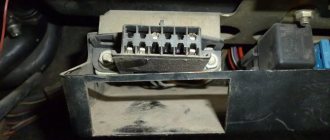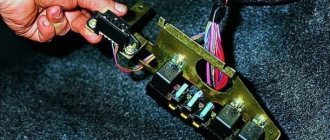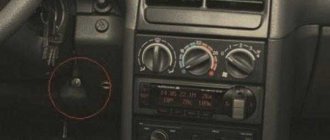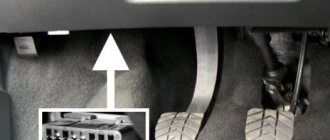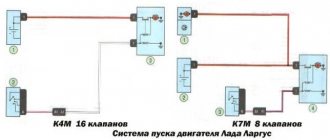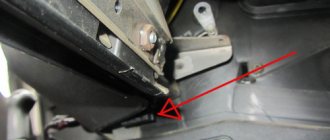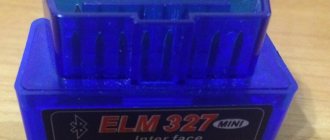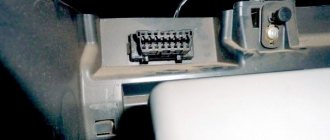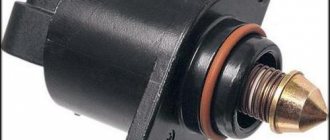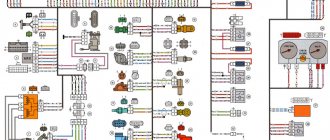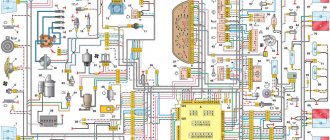It is important to know that on different cars the required socket is located in different parts of the car. Moreover, on some AvtoVAZ models it may be in a completely different place compared to another car. Let's look at several VAZ cars as an example:
Diagnostics of modern car models is carried out using a special diagnostic connector. It connects to a computer, which analyzes the current state of the vehicle, determines the malfunction and indicates it. If you have the appropriate equipment, you can look for breakdowns even at home. However, not all VAZ-2112 owners can find the diagnostic connector right away. Today we’ll talk about its location on the classic panel and on the Europanel. In which part of the car should I look for the required socket?
Nowadays there are scanner models with different versions of firmware and chips on sale. Scan Tool Pro with firmware 2022 is the most stable version so far. The scanner has maximum compatibility with cars manufactured since 2001, including VAZ 2112 with OBD2 connector and GM12 when connected via an adapter.
Connector location and features
On VAZ 2114 and 2115 cars, where a Europanel is installed, the diagnostic connector (DR) is located on the central control panel under the cigarette lighter. It is closed by a decorative plug. To access the connector, just pry off the plug and it can be easily removed.
Location on VAZ 2114
VAZs can be equipped with a 12-pin rectangular connector of the old style OBD 1 (GM-12) or a 16-pin OBD-II connector in the form of a trapezoid USB-KKL. If the adapter is intended for OBD-II AR, you can buy an adapter.
Pinout
Knowledge of pinouts may be required if a car enthusiast wants to make an adapter for computer diagnostics with his own hands, or if you need to connect without one. Experts recommend buying ready-made devices without the need to make a plug yourself. However, if you do not have such an opportunity, and diagnostics need to be carried out urgently, we will consider two main pinout options used on VAZ cars of various years of manufacture. Until 2002, AvtoVAZ products used the following pinout option:
- The 4th and 5th pins are GND outputs.
- Pin 16 – +12 V (power line).
- The 7th contact is the diagnostic line itself.
Since 2002, the pinout scheme has changed significantly. Now it looks like this:
- Pin H – +12 V (power line).
- Contact G – +12 V for the fuel pump.
- Pin A – GND output.
- Contact M – diagnostic line.
There is one important note to note regarding this diagram. If you connect the connector without a block, but directly, it is recommended to use the charge from the cigarette lighter as a source of electricity. The peculiarity of this pinout is that contact H is not always routed in the car. The use of G is also not recommended because high frequency current is supplied. This can have a negative impact on the adapter, even to the point of burning it out. However, cases of burning out the fuel pump connector are quite rare. Therefore, if you wish, you can also use this option.
As you can see, the pinout on VAZ cars of different ages is sometimes very different. Therefore, we advise you to look at the registration certificate of your car and find out what year it is made. On older vehicles you will not find the new pinout design as it did not exist yet and on newer vehicles the old design was no longer used.
Reading time
Difficulty of the material:
For fans - 3 out of 5
To diagnose a VAZ 2114, 2113 or update the ECU firmware, car owners, diagnosticians or mechanics need to know the location of the OBD2 diagnostic connector, as well as its pinout and type. To flash the electronic unit or replace it, you also need to know the location of the ECU and the purpose of the pins.
When is diagnosis necessary?
Many car enthusiasts are frightened by the “Check Engine” signal appearing on the panel, which reports malfunctions in the operation of the vehicle systems. The easiest way out in this case is to visit a service station. But this is associated with both financial costs and loss of time. Thanks to the DR that has appeared on modern cars, computer diagnostics of the VAZ 2114 and VAZ 2115 has become possible, which you can do yourself. To do this, you need to purchase a diagnostic adapter and have a device to which it can be connected: a computer, laptop or other device.
The ability to independently diagnose a car will allow you to:
- quickly identify vehicle malfunctions;
- obtain the necessary information from sensors;
- change settings;
- save on visiting a service station.
The need for diagnostics arises primarily when the “Check Engine” sign is displayed, but it is not a bad idea to carry out regular diagnostics for prevention.
"Check Engine" sign
You can carry out additional diagnostics using a compression meter and a multimeter. During an additional check, you should check the level of fluids in the car systems, do a visual inspection of the car body and components for mechanical damage. Next, you need to check the compression in the cylinders, the battery charge, the condition of the valves, high voltages and spark plugs. Having made a preliminary diagnosis, you can begin computer diagnostics.
Basic blocking methods
Today, blocking the diagnostic connector is one of the main options for protecting your vehicle from theft. Thanks to the blocking, the car owner will be able to prevent illegal connection to various car systems and avoid possible bypass of the anti-theft system using software. If the engine is blocked, the criminal will not be able to check the blocked motor elements.
There can be several options for blocking a device:
- The first of them is the transfer of the AR itself to another place. So an attacker who tries to steal a car will be faced with the problem of finding an AR that can be installed anywhere. The car owner can move the device to the engine compartment or hide it somewhere in the cabin.
- Re-pinning the DR contacts and making a special adapter for its use. In this case, you only need to reassign a few wires on the device. But in order to use such an DR, you will need a special adapter, where the contacts will also be re-pinned. Otherwise, diagnosing the vehicle will be impossible.
- Complete removal of the AR and installation of a non-standard device in its place. In the future, to carry out diagnostics, you will need a counterpart from such an DR with a block of wires, that is, essentially the same adapter.
- Another method that has recently become widespread is the use of the so-called secret. The secret is a device designed to enhance the functions of the installed immobilizer. As a rule, most modern manufacturers manufacture secret components in such a way that the design of the DR remains the same, and no adapters are needed for its operation. In the event of an attempted theft, the wiring that comes from the DR in the passenger compartment and in the engine compartment is blocked, and a control circuit is placed in the resulting gap. As for control, it all depends on the device manufacturer. For example, an additional DR can be installed, which will be displayed in another location, and sometimes control can be carried out via SMS commands.
Loading …
Instructions for performing diagnostics via a laptop with your own hands
For diagnostics you will need a laptop and a diagnostic adapter. The laptop can be of any power, it does not matter for diagnosis. The adapter is universal and suitable for all VAZ models (the author of the video is KV Avtoservis).
There may be a mismatch between the diagnostic pads. In this case, you can buy an adapter. A diagnostic program is supplied with the adapter, but the software can be downloaded from the Internet on specialized sites. They have the same set of functions, but may differ in unique features.
When connecting a laptop, the ignition must be turned off.
One end of the adapter is inserted into the DR, and the other directly into the USB port of the laptop. After connecting the adapter, turn on the ignition. At the next stage, we launch the program and begin diagnostic work. When the program starts, the computer connects to the electronic control unit.
The interface will depend on the downloaded program. These can be lists with indicators or graphs with values. Based on these readings, we can draw the first conclusions about the operation of the engine and the main systems of the car.
Diagnostic Tool Interface
When a list of detected errors is displayed, their decryption can be found in the test file, which is usually attached to the program. It deciphers all the errors that may appear during malfunctions.
Having deciphered the codes of detected errors, you should begin to eliminate them. First of all, it is worth checking the sensors, since the correctness of the readings and operation of the ECU depends on their serviceability. A sensor malfunction may cause the error to appear. For more accurate diagnostics, additional checks of machine components may be necessary. After fixing all the problems, be sure to run a test to make sure everything is working without errors.
Don't forget that all data is stored in the microcontroller's memory. Therefore, before a new check, they need to be reset.
To do this, turn off the ignition and turn off the diagnostic equipment. To reset data from the microcontroller, simply disconnect the negative terminal on the battery. Then the process is repeated: the laptop is connected and diagnostics are repeated. The process is repeated until all errors are eliminated.
Video “Review of the DR locking system”
From the video below you can get acquainted with one of the most modern systems for blocking DR from car theft (the author of the video is the Ugona.net channel - anti-theft protection).
With the advent of electronic control systems from microprocessors in cars, the need also arose to check the operating parameters of the units themselves and the connecting electrical circuits. For this purpose, equipment was invented, called OBD (On Board Diagnostic), initially it only provided information about the malfunction, without any clarification.
In modern cars, using an OBD connector with a standard pinout of the diagnostic connector, you can connect a special adapter or scanner to the on-board computer and carry out a complete diagnosis on your own for almost any motorist. Since 1996, the second concept of the OBD2 standard has been developed in the USA, which has become mandatory for newly produced cars.
Determine the purpose of OBD2:
type of diagnostic connector;
connector pinout for diagnostics;
electrical communication protocols;
The European Union has adopted EOBD, which is based on OBD2. It has been mandatory for all cars since January 2001. OBD-2 supports 5 data exchange protocols.
Knowing the location and standard pinout of the OBD2 connector, you can check the car yourself. Thanks to the widespread implementation of OBD2, when diagnosing a car, you can get an error code that will be the same regardless of the make and model of the car.
The standard code contains the X1234 structure, where each character carries its own meaning:
X is the only letter symbol that allows you to recognize the faulty system (engine, gearbox, electronic components, etc.);
1 - represents the general OBD2 standard code or additional factory codes;
2 - clarification of the location of the malfunction (power or ignition system, auxiliary circuits, etc.);
34 is the serial number of the error.
The pinout of the OBD2 diagnostic connector has a special power plug from the on-board network, this allows you to use any scanners and adapters without additional electrical circuits. If earlier diagnostic protocols showed only general information about the presence of a problem, now, thanks to the connection of the diagnostic device with the electronic units of the car, more complete information about a specific malfunction can be read.
Each connected diagnostic equipment must comply with one of three international standards:
The location of the OBD2 diagnostic connector and pinout for diagnostics can vary greatly from vehicle to vehicle. There is no single standard for location; the car's operating instructions or sleight of hand will help you here.
VAZ diagnostics - It's easy!
Not only owners of imported cars have access to the possibility of self-diagnosis.
Many VAZ car models, including the “classic” 2105, 2107, not to mention the more modern models 2108, 2109, 2110, 2112, 2114, 2115, Priora, Kalina, are equipped with electronic control units, and, therefore, we have the opportunity perform their diagnostics yourself. Not only owners of imported cars have access to the possibility of self-diagnosis. Many VAZ car models, including the “classic” 2105, 2107, not to mention the more modern models 2108, 2109, 2110, 2112, 2114, 2115, Priora, Kalina, are equipped with electronic control units, and, therefore, we have the opportunity perform their diagnostics yourself.
Installing a new adapter
Modern adapters elm 327 with the OBD-II program (puncture) are suitable for the VAZ 2110 . You can also install them yourself. First you need to purchase an elm 327 and a cable for it. You already know the location of the diagnostic connector. Be sure to study the instructions, which indicate the pinout of the block and the location of each connector.
Connection diagram for ELM327 to 12 PIN diagnostic block
The pad can be removed quite easily. Insert your own cable into each connector of the block, making sure that the pinout of the elm 327 complies with the manufacturer’s instructions. Check that each connector is connected correctly and each cable is in the correct place. After this, the block is installed in its place.
Why is diagnostics of a VAZ car necessary?
A frequent case that worries a car enthusiast is the “check engine” signal, which notifies about a malfunction of the car system. This is usually a reason to visit a service station, but today we have the opportunity to identify the cause of the alarm ourselves; this will require a diagnostic adapter. With its help, you can quite simply carry out diagnostic measures - identify malfunctions, determine malfunctions of your car, change settings, and obtain information from sensors. And all this with minimal financial investment.
Deciphering error codes
The first character is a letter and indicates a fault block:
- B - body;
- C - suspension;
- P — engine (ECM, gearbox);
- U - data exchange bus.
The second character is a number, code type:
- 0 — SAE (standard);
- 1.2 - OEM (factory);
- 3 - reserved.
The third character is a number, system:
- 1, 2 - fuel system;
- 3 - ignition system;
- 4 — reduction of exhaust gas toxicity;
- 5 - idle;
- 6 - ECU or its circuits;
- 7, 8 — transmission (automatic transmission).
The fourth and fifth characters are numbers, the error code itself.
To diagnose a VAZ 2114, 2113 or update the ECU firmware, car owners, diagnosticians or mechanics need to know the location of the OBD2 diagnostic connector, as well as its pinout and type. To flash the electronic unit or replace it, you also need to know the location of the ECU and the purpose of the pins.
Which adapter to choose for VAZ
Before you buy a scanner for diagnostics, you need to find out which control unit is installed on your vehicle. Most models are equipped with control units with a K-line for data exchange. Therefore, the best choice is a VAGCOM diagnostic cable or an improved version of the K-Line diagnostic adapter. These adapters are suitable for diagnosing VAZ vehicles and ensure correct coordination of the vehicle's diagnostic system and computer. Please note that you will be able to perform full computer diagnostics, just like specialists at a service station.
Why does the OBD2 GM12 pin adapter for VAZ, Daewoo not work?
Having ordered an OBD2 - GM 12pin diagnostic cable and connecting it to a VAZ family car, many are faced with various troubles.
The best, so to speak, of which is simply the impossibility of diagnosing the car, but there are also cases where the fuel pump turns on or there is a short circuit in the electrical wiring, and if you’re lucky, the matter will be dealt with by simply replacing the fuses.
After such experiments, the average person takes the cable in his hands and, waving it, scolds the seller and the manufacturer.
The above troubles are usually a consequence of incorrect cable pinout, that is, power is supplied to the device along the wire through which information is to be read, or power is supplied to the fuel pump along the wire through which power is supplied. And what do you tell the latter to do? Right! Turn on and work.
But no matter how strange and incomprehensible everything now turns out to be, and it may sound absurd, the cable actually turns out to be serviceable and working. Yes, yes, workers, and even the pinout is correct. Correct, but not suitable for our car brand.
How so? You ask? And the answer here is simple. The cord is only intended for a different brand of car, and this brand is called nothing less than DAEWOO.
Difficulty connecting the adapter to the VAZ ECU
VAGCOM, K-Line adapters are designed for direct connection to the ECU via a 16-pin OBD-II connector. It began to be installed on VAZ cars after 2002. Some models are equipped with a 12 pin connector. It is not compatible with the adapter connector. The solution is simple: purchase a GM12 adapter or a K-Line adapter in an OBD1 (GM12) housing.
OBD2 pinout - 16 PIN
Description:
The OBD2 connector is trapezoidal and consists of 16 pins.
Brands and years:
Gasoline passenger cars and light commercial vehicles manufactured or imported into the United States since 1996 (US CARB and EPA legislation) and in Europe (EOBD) since 2000-2001 (European Union Directive 98/69EG) and Asia (mainly since 1998). ).
Access and location:
Pinout:
| 1 | 2 | 3 | 4 | 5 | 6 | 7 | 8 |
| 9 | 10 | 11 | 12 | 13 | 14 | 15 | 16 |
| Smaller side of trapezoid | |||||||
Example in the photo:
Conclusions and their purpose:
| № | Color | Purpose |
| 2 | J1850 Bus + | |
| 4 | Body grounding | |
| 5 | Signal Ground | |
| 6 | Line CAN-High, J-2284 | |
| 7 | K-line diagnostics (ISO 9141-2 and ISO/DIS 14230-4) | |
| 10 | J1850 Bus- | |
| 14 | Line CAN-Low, J-2284 | |
| 15 | L-line diagnostics (ISO 9141-2 and ISO/DIS 14230-4) | |
| 16 | Power supply +12V from battery |
Diagnostic connector pins for used protocols
Pins 4, 5, 7, 15, 16 - ISO 9141-2.
Pins 2, 4, 5, 10, 16 - J1850 PWM.
Pins 2, 4, 5, 16 (without 10) - J1850 VPW.
The ISO 9141-2 protocol is identified by the presence of pin 7 and the absence of pins 2 and/or 10 on the diagnostic connector.
If pin 7 is missing, the system uses the SAE J1850 VPW (Variable Pulse Width Modulation) or SAE J1850 PWM (Pulse Width Modulation) protocol.
All three data exchange protocols operate via a standard OBD-II J1962 connector cable.
The correct connection diagram for a 12 PIN block with a 16 PIN adapter
Where is the diagnostic connector located?
The typical location of the diagnostic connector on VAZ cars is in the passenger compartment under the dashboard. But at the same time, its location differs on different models:
- On VAZ 21099i, VAZ 2108i - below the shelf, on the passenger side;
- On VAZ 2115 – below the cigarette lighter;
- VAZ 2112, VAZ 2111, VAZ 2110 – to the right of the steering column;
- Kalina - above the cigarette lighter;
- Priora - the connector is located behind the glove box.
How to diagnose a car
- Connect contact “B”, which has the diagnostic block and “ground”;
- Turn the ignition key to the third position, do not start the car;
- First, the “CHECK ENGINE” lamp displays code 12 with 3 flashes. It shows that the diagnostic programs are working. On the VAZ 2110 this happens in this order: the lamp blinks briefly 1 time (which should be considered the designation of number 1). After a pause lasting at least 2 seconds, it flashes 2 times in a row (two). So we got the number two. And this is repeated 3 times so that the driver understands these signs;
- After the diagnostic program has declared its serviceability, it will begin to display error codes, if there are any, of course. In the same way - flashes and pauses.
Which computer can be used for diagnostics?
The diagnostic software does not require PC resources; for this reason, you can use any computer with an operating system no lower than Windows XP. It is very convenient to use a laptop or netbook for diagnostics, since the cable length is limited.
Scanner for VAZ
is as necessary a tool in a car enthusiast’s arsenal as a regular wrench. The advantages of using it are obvious, you can quickly assess the condition of your car’s systems, identify the cause of the malfunction, many of them can be eliminated yourself without contacting a service station. It is also beneficial economically. The price of a diagnostic k-line adapter is no more than the cost of a one-time visit to a service center or service station.
Sources
- zen.yandex.ru/media/id/5bd2b0fe32ca1500aac617ec/diagnostika-vaz—eto-prosto-5bd2cea313f8c600a99a1283
- avtozam.com/vaz/2114/2115-samostoyatelnaya-diagnostika/
- drive2.ru/b/1256509/
Diagnostic history with OBD II
Initially, few people cared about the convenience of automotive diagnosticians. Microcomputers that control the machine’s components could be checked using dealer tools that are not available for free sale and are not provided with open source codes. Therefore, the first step was taken by government organizations designed to monitor the environmental cleanliness of transport.
A control standard appeared in the United States, where California has always been famous as the most demanding state in limiting environmental pollution from internal combustion engines.
On the subject: What is a CAN bus in a car (device and connection diagram)
By the mid-90s, the description of the connector was finally formed in the form of OBD II, that is, the second final version. On-Board Diagnostics II became mandatory for all vehicles in the United States after 1996.
What is EOBD
The abbreviation EOBD does not add much meaning to the concept of OBD, and there is not even an exact definition of what the additional letter at the beginning means.
It could be an abbreviation for European, a hint at additional Enhanced abilities, or simply a meaningless Electronic prefix (there are simply no others).
But more often they are inclined to begin introducing a positive American standard into the production of European cars. Moreover, the US market has always been considered the most important.
As a result, in parallel with the American standards for the diagnostic interface SAE, global ISOs were also formed.
In most cases, they are identical, but with different alphanumeric designations, and more often the one that appeared earlier is used. This applies to physical and logical layer protocols.
How to connect on Android
To connect the ELM327 scanner, a special socket is used, which is located under the steering block of the car (in the passenger compartment).
Healthy! If the scanner is installed on a VAZ and other domestic cars produced before 2006, then most likely you will need to use an adapter or adapter.
- Download the small Torque utility from Google Play. This application is considered the best, as it allows you to additionally read car system errors.
- Connect the ELM327 to the appropriate connector.
- Start the car engine.
- Activate Bluetooth on your mobile device.
- Go to your smartphone settings and go to “Bluetooth Wireless Networks”.
- Click on “Search for new equipment”.
- Wait until the list of available devices is displayed on the phone screen.
- Select OBD 2 from them and connect to it. To do this, you need to specify a special pairing code, most often it is 1234 or 0000.
- When the ELM 327 bluetooth connection is completed, you can proceed to the settings. To do this, go to Torque and select “OBD 2 adapter settings”.
- Next, you need to select the Bluetooth device, that is, the ELM 327 scanner itself.
After some time, the connection will be established, and you can begin diagnosing the vehicle systems.
